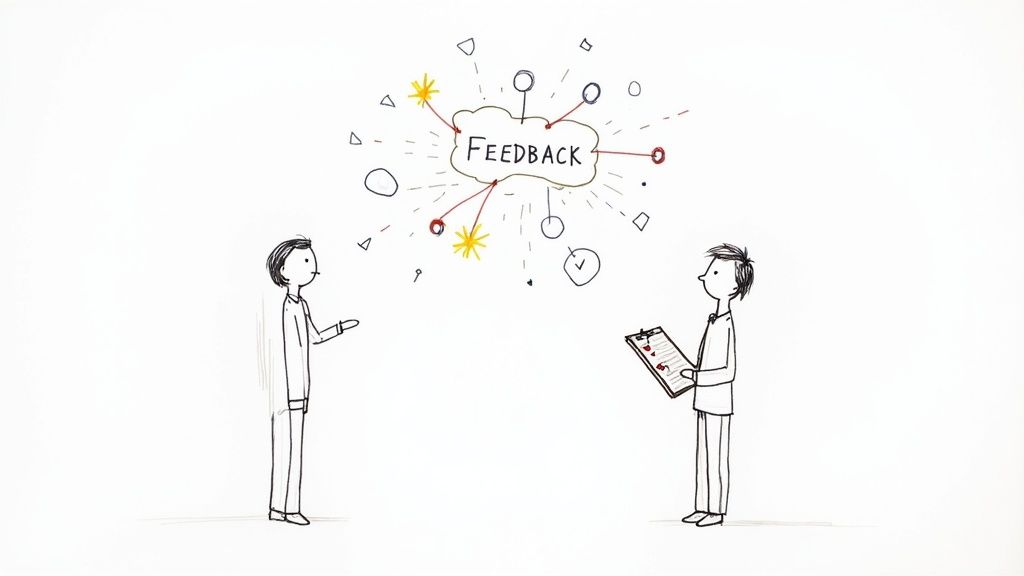Let's be honest. The term "digital transformation" gets thrown around so much it’s easy to tune it out. It sounds like another buzzword cooked up by consultants to sell you complicated, expensive software that ends up being little more than a fancy spreadsheet. I’ve seen it a dozen times.
But when we talk about digital transformation in human resources, we're talking about something real. It’s a fundamental shift in how your HR department works, thinks, and contributes to the business. Or, at least, it should be.
This is about moving from a team drowning in paperwork to becoming a strategic engine that actually drives business growth. It isn’t about replacing people with robots; it's about freeing them from robotic, repetitive work so they can focus on what really matters—your people.
What Is Digital Transformation in HR Really?
So, what does this actually look like on the ground?
Forget the jargon for a second. At its core, digital HR transformation is the move from reacting to predicting. It's swapping out those endless, manual onboarding checklists for an automated system that helps new hires feel welcome and become productive from day one. It’s trading gut feelings in interviews for hard data that shows you who will actually stick around and perform well.
Forget the textbook definitions. In the real world, this means using analytics to flag a flight risk before they even touch up their LinkedIn profile. It’s about arming your team with real data to make smarter, faster, and more human-centric decisions.
From Paper Pushing to People Strategy
The old model of HR was built for a different era—one of filing cabinets, strict nine-to-five office hours, and predictable career paths. That world is long gone. Today, your HR team needs to be just as agile and data-driven as your marketing or sales departments. Seriously.
This transformation is about completely changing the core function of HR.
- From Administrative Gatekeepers: Where the primary jobs were processing payroll, managing benefits claims, and keeping records straight.
- To Strategic Partners: Where the focus is on analyzing workforce trends, boosting employee retention, and directly contributing to the company's bottom line.
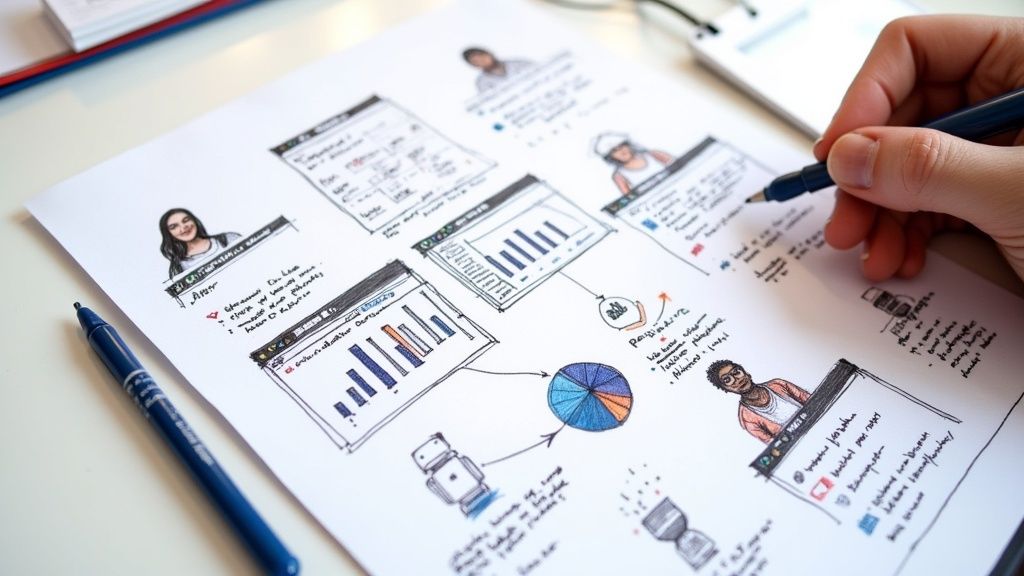
This shift isn't just a "nice-to-have" anymore; it’s a necessity. The change is happening fast. By 2025, the widespread use of AI and advanced Human Resource Management Software (HRMS) will continue to automate routine tasks, pushing HR professionals to focus more on big-picture strategy. You can discover more insights about this HR evolution on SelectSoftware Reviews.
To put it in perspective, let's look at the old way versus the new way.
The Shift From Traditional HR to Digital HR
| Traditional HR Task | Digital HR Reality |
|---|---|
| Manual, paper-based onboarding | Automated, personalized digital onboarding journeys |
| Gut-feel hiring decisions | Data-driven recruitment with predictive analytics |
| Annual, backward-looking performance reviews | Continuous, real-time feedback and development conversations |
| Reactive problem-solving (e.g., exit interviews) | Proactive retention strategies using employee sentiment data |
| Filing cabinets and spreadsheets for records | Centralized, secure cloud-based HR Information Systems (HRIS) |
| HR seen as a cost center | HR positioned as a strategic driver of business value |
See the difference? The goal isn't just to buy new software. It's to build a whole new operating system for your people operations—one designed for the way we actually work today.
It’s less about managing human "resources" and more about empowering human potential. And that, right there, is a change worth making. No buzzwords required.
Why Your Old-School HR Is Quietly Costing You
If you're still running HR on spreadsheets and a prayer, you’re not just behind the curve; you're actively bleeding cash and talent. This isn't fear-mongering. It’s a frank look at the hidden costs that are quietly eating away at your bottom line.
Think about it. Every hour your HR team spends manually chasing down paperwork for a new hire is an hour they’re not spending on retaining your top performers. That’s a direct, tangible cost.
The $500 Hello and Other Hidden Expenses
The real price of sticking with manual processes isn't just about inefficiency; it’s about the costly mistakes that fester in outdated systems. We’ve all been there—making a hire based on a great interview and a polished resume, only to find out three months later that they're a terrible fit.
That’s not just an "oops." That’s a blunder that can cost up to 2.5 times the employee's salary. When your hiring process is a mix of gut feelings and inconsistent interviews, you’re essentially gambling with your payroll.
A solid digital HR strategy changes the game. It introduces consistency and data into the equation, which is the best defense you have in a brutal war for talent.
Your old-school HR isn’t a charming quirk of your company culture. It’s a leaky bucket. You can keep pouring talent and money into it, or you can fix the damn holes.
Death by a Thousand Paper Cuts
The damage isn't just in big, obvious hiring mistakes. It’s in the slow, daily grind that wears down your best people—both in HR and across the company.
- The Onboarding Black Hole: When a new hire’s first week is a frustrating scavenger hunt for logins, forms, and basic information, you've already failed them. A clunky onboarding experience makes your company look disorganized and can send new hire turnover skyrocketing.
- The Talent You Never See: Are you still posting on a single job board and hoping for the best? Modern Applicant Tracking Systems (ATS) use AI to source candidates from multiple channels, finding A-players you would have otherwise missed entirely. Turns out there’s more than one way to hire elite developers without mortgaging your office ping-pong table.
- The Engagement Nosedive: Manual HR means your team is buried in admin. They have no time to focus on culture, development, or checking in with employees. A failure to modernize can also lead to serious employee engagement challenges and even potential legal troubles down the line.
These aren't just minor annoyances. They are systemic problems that directly impact retention, productivity, and your ability to compete. This is where digital transformation stops being a buzzword and becomes a survival strategy. To get ahead, you'll need to learn from the best, and our guide on recruitment process best practices is the perfect place to start.
Turning a Cost Center into a Powerhouse
Ultimately, clinging to outdated HR methods is a choice. It's choosing to accept higher turnover, lower productivity, and a weaker talent pipeline. The alternative is investing in a digital infrastructure that quickly pays for itself.
By automating the robotic tasks, you free up your people to be more human. They can build relationships, mentor new hires, and develop retention strategies based on real data, not guesswork. This transforms HR from a department that just pushes paper to a strategic partner that builds the team you need to win.
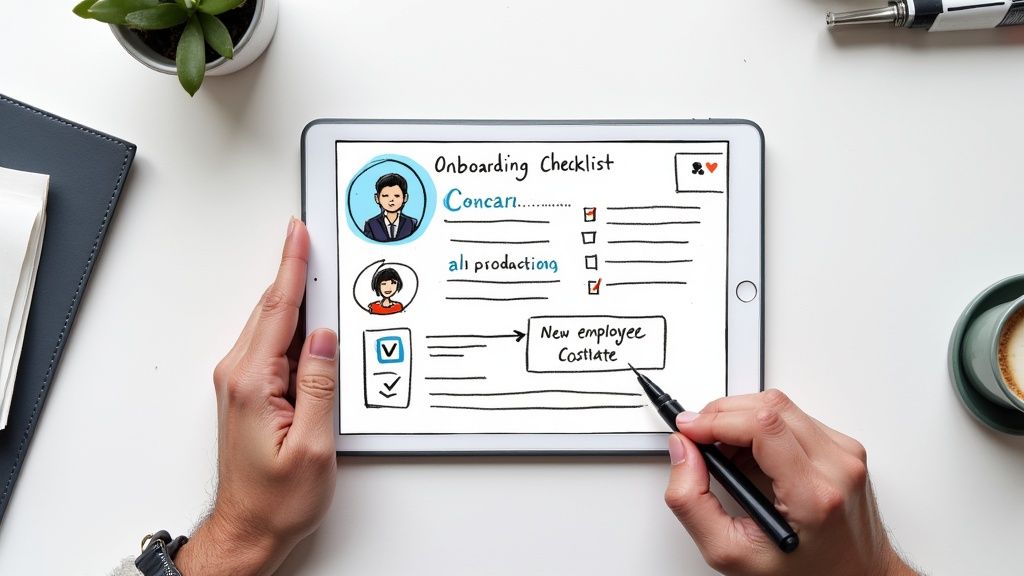
It's your best defense in an era of remote work and unpredictable turnover. The question isn't whether you can afford to modernize your HR—it's whether you can afford not to.
The Pillars of a Rock-Solid Digital HR Strategy
Alright, so you’re bought in. You see how the old way is bleeding you dry and you’re ready to make a change. Now what? Building a digital HR ecosystem isn’t about buying the first shiny tool a salesperson dangles in front of you. That’s a recipe for expensive shelfware.
A real digital transformation in human resources requires a deliberate blueprint, built on a few core pillars. Get these right, and you’ll build something that actually works. Miss one, and the whole thing comes crashing down.
From Data Hoarder to Decision-Maker
First up, let's talk about data. Most companies are sitting on a mountain of HR data—turnover rates, time-to-hire, performance reviews—but they treat it like a dusty attic full of junk they never look at. It's time to stop being a digital hoarder and start being a data-driven decision-maker.
This means transforming raw numbers into a genuine superpower. It’s not about generating more reports nobody reads. It’s about asking smarter questions.
- Instead of: "What was our turnover last quarter?"
- Ask: "Which department has the highest turnover, what traits do those departing employees share, and can we predict who is next?"
See the difference? One is history; the other is strategy. The goal is to move up the analytics food chain from simply describing what happened to predicting what will happen next.
This infographic breaks down the HR analytics maturity levels, showing the journey from basic reporting to strategic forecasting.
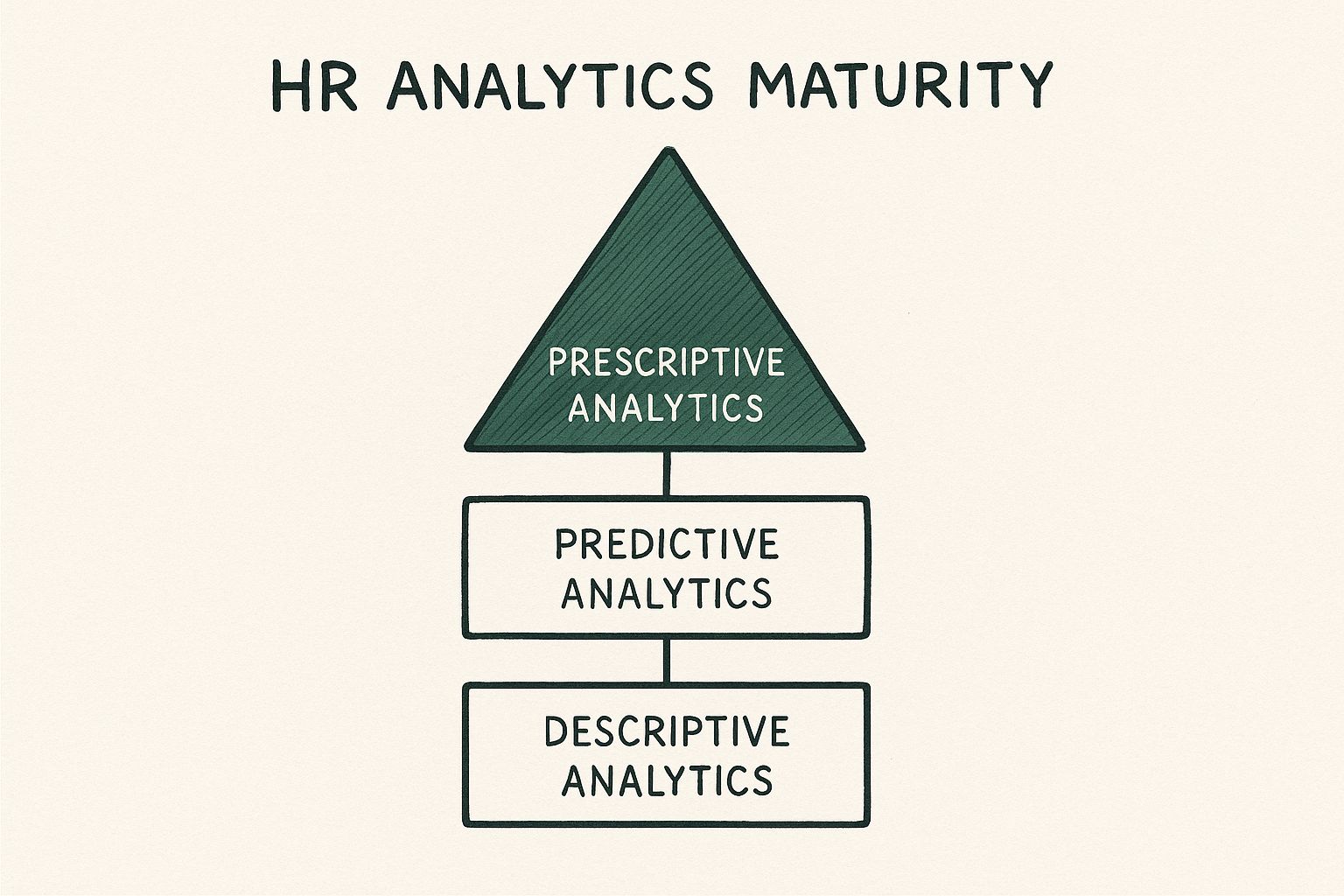
The key insight here is that true strategic value is unlocked only when you move past descriptive analytics and start using data to guide future actions.
Automation That Actually Helps
Next up is automation. This is where you identify the soul-crushing, repetitive tasks that burn out your best people and hand them over to machines. I'm not talking about replacing your team with robots; I’m talking about freeing them from being robots.
Think about the time wasted on screening hundreds of resumes for a single open role. It’s a mind-numbing process that’s prone to human error and bias. Automating that initial screen frees up your recruiters to do what they do best: talk to high-potential candidates and build relationships. It’s one of the simplest ways to dramatically boost your team’s output. For more on this, check out our guide on how to improve recruiting efficiency.
Automation isn't about removing the human element from HR. It's about removing the inhuman element—the mind-numbing, repetitive work that prevents your team from focusing on people.
If Your Tech Sucks, Your Team Will Hate It
This one sounds obvious, but you’d be amazed how many companies get it wrong. The employee experience is everything. If your new, expensive tech makes life harder for your team, you've already failed. Full stop.
Your digital tools should feel intuitive, not like a homework assignment. Is your new performance management system a clean, simple platform for continuous feedback, or is it a clunky portal that everyone dreads logging into? Does your application process take two minutes on a phone, or does it require a candidate to re-enter their entire resume manually?
Every friction point you create is a tiny tear in your company culture. Get the employee experience right, and the technology will feel invisible.
Building a Culture of Adaptation
Finally, the most important pillar: culture. You can buy the best software in the world, but if your team isn't willing to adapt, it’s useless. Digital transformation is a people project, not an IT project.
This means being transparent about why changes are happening and what’s in it for them. It means training people properly and celebrating small wins along the way. Critically, it also involves empowering your team with clearer, data-driven goals. Studies show that digital HR platforms help companies adopt more scientific performance management methods, empowering employees to self-manage and collaborate more effectively across departments.
Without a culture that embraces change, your shiny new digital strategy is just a very expensive dream. With it, you'll build an HR function that’s not just efficient, but a true competitive advantage.
Your Digital HR Toolkit: Essential Tech You Actually Need
Let's talk tools. But forget the slick sales pitches and the promises of a one-click utopia for a minute. The truth is, most HR tech is either a genuine game-changer or a glorified, overpriced spreadsheet. The trick is knowing the difference before you sign the contract.
I’ve wasted more money on useless software than I care to admit, so you don’t have to. Here’s a brutally honest look at the tech you actually need to drive a real digital transformation in human resources. This is your essential, no-fluff toolkit.
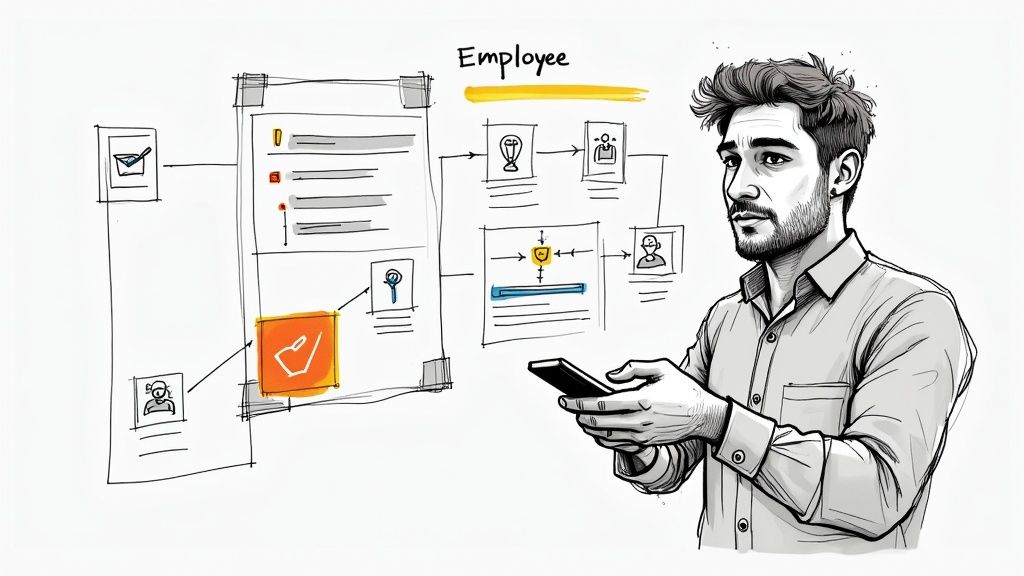
This chart gives you a sense of the explosion in HR tech categories, which is both a blessing and a curse. It’s great that there are tools for everything, but it's also incredibly easy to get lost in the noise and build a Frankenstein's monster of systems that don't talk to each other.
The Non-Negotiable Core: Your HRIS
First things first, you need a central nervous system for all your people data. That’s your Human Resource Information System (HRIS). If you’re still wrestling with a chaotic mess of spreadsheets to track payroll, time off, and employee records, stop right now. You’re practically begging for a compliance nightmare.
A modern HRIS isn’t just a digital filing cabinet; it's the single source of truth that powers everything else you do. But be warned: not all are created equal.
- What to look for: A clean user interface that employees won’t hate, seamless payroll integration, and robust reporting that gives you actual insights.
- What to avoid: Clunky, legacy systems that feel like they were designed in 1998. If it requires a week of training just to request a day off, run.
The Gatekeeper: An ATS That Doesn’t Suck
Your Applicant Tracking System (ATS) is the front door to your company. Is it a welcoming entrance or a broken, revolving door that frustrates top talent into giving up? If your application process still makes candidates manually re-enter their entire work history right after uploading a resume, you’ve already lost the best ones.
A good ATS automates the soul-crushing parts of recruiting—sourcing, screening, scheduling—so your team can focus on the human parts. It should feel less like a clunky database and more like a command center for your entire hiring pipeline.
An ATS should make a recruiter's life easier and a candidate's experience respectable. If it fails at either, it's just expensive clutter.
Beyond The Annual Review: Performance Management Tools
Can we all agree to kill the annual performance review? It’s a backward-looking, anxiety-inducing ritual that pretty much everyone dreads. Modern performance management is all about continuous feedback, real-time goal tracking, and forward-looking development conversations.
The right tool is what makes this shift possible. It makes it easy for managers and employees to have quick check-ins, share praise, and track progress against goals without a mountain of paperwork. The goal here is to foster a culture of coaching, not just judging.
The Advanced Arsenal: Tech That Gives You an Edge
Once you’ve nailed the basics, you can start adding more specialized weapons to your arsenal. This is where things get interesting and where you can gain a serious competitive advantage.
-
People Analytics Platforms: This is where you go from just reporting on what happened to predicting what will happen next. These tools connect all your disparate HR data—from hiring and performance to engagement and turnover—to uncover the hidden trends. You can finally get answers to questions like, "Which of our top performers are most likely to leave in the next six months?"
-
Asynchronous Interview Tools: Let’s be real, scheduling interviews is a logistical nightmare that slows the whole process down to a crawl. Asynchronous video tools like our own Async Interview let you screen way more candidates in a fraction of the time. You send the questions, they record their answers on their own time. It’s faster for you, more flexible for them, and a shockingly effective way to get a real sense of a candidate beyond their resume. (Toot, toot!)
-
Learning and Development (L&D) Platforms: Keeping your team’s skills sharp isn't a luxury anymore; it’s a necessity. Modern L&D platforms offer personalized learning paths, on-demand courses, and even immersive training experiences. Technologies like augmented reality are becoming indispensable here. For instance, you can see how Augmented Reality for Training Your Workforce can revolutionize skill development and retention.
Building your digital HR toolkit is an ongoing process, not a one-time shopping spree. Start with a solid foundation and then add tools that solve specific, painful problems. Don’t chase every shiny new object—focus on tech that makes your team smarter, your processes faster, and your employee experience undeniably better.
A Practical Roadmap for Implementing Your HR Tech
So, you’ve picked out your shiny new HR tech. That's the easy part. Now comes the real work—the part where a staggering 70% of digital transformations fail. Most grand plans don't crash and burn because of bad tech; they die because they’re treated like an IT project instead of a people project. This isn't about flipping a switch; it's about fundamentally changing how people work.
Here’s a practical, step-by-step roadmap that, hopefully, won't get you fired.
Step 1: Start With People, Not Platforms
Before you sign a single check or schedule a single kickoff meeting, you need buy-in. I don't mean a quick head-nod from the C-suite, either. I mean genuine, on-the-ground support from the managers and employees who will actually have to use this thing every single day.
Forget the corporate jargon about "synergies" and "optimizing workflows." You need to talk to them like human beings and answer the one question they all have: "What's in it for me?"
- For Managers: Frame it around their biggest headaches. "Remember how long it took to get your last new hire approved? This new system cuts that time in half."
- For Employees: Focus on making their lives easier. "This will make requesting time off a two-click process on your phone instead of a scavenger hunt for a PDF form."
If you can't clearly articulate how this new tool makes their day-to-day work better, you've already lost. The goal is to build a coalition of champions who are excited about the change, not just a list of passive users.
Step 2: Run a Pilot Program Before You Go Big
Ready to roll out that new system to all 500 employees at once? Please, for the love of all that is holy, don't. That’s how a small, fixable bug turns into a full-blown, company-wide meltdown.
Instead, start small. Run a pilot program with a single, tech-friendly department. Think of it as a dress rehearsal. This small-scale test is your golden opportunity to find the awkward bugs, confusing instructions, and unforeseen problems in a safe, low-stakes environment.
A pilot program isn't about a lack of confidence; it's about a surplus of common sense. It's much better to discover your new system is a disaster with ten people than with ten hundred.
This is where you collect brutally honest feedback. What’s clunky? What’s confusing? What feature did the salesperson promise that doesn't actually exist? Ironing out these kinks before a full launch will save you an ocean of pain later on. As you map out these steps, your focus should be on leveraging digital workflow automation to make every process as smooth as possible.
Step 3: Train Like Your Job Depends on It
Let's be clear: a single launch-day email with a link to a 50-page user manual doesn't count as training. It counts as a cry for help.
Real, effective training is all about building competence and confidence. It needs to be hands-on, role-specific, and ongoing. Show people exactly how the new tool solves their specific problems. This isn’t just about showing them which buttons to click; it’s about constantly reinforcing the why behind the change. The goal is to make work more human, not more technical.
This also ties directly into the bigger picture of workforce development. Looking toward 2025, a major barrier to business growth is the skills gap, something 63% of employers are worried about. To combat this, 85% of organizations are prioritizing upskilling their current teams to adapt. Your training program is a direct investment in that future.
Step 4: Measure What Actually Matters
Finally, how do you know if any of this is actually working? You have to measure success with metrics that matter to the business, not just vanity stats. Sure, you can track "employee logins," but that doesn't tell you anything useful. "Time-to-hire," on the other hand, tells you a story.
Here are a few KPIs you should actually be tracking:
- Time-to-Hire: How long does it take to get a great candidate from application to offer letter? If this number isn't dropping, your new Applicant Tracking System isn't pulling its weight.
- New Hire Turnover Rate (First 90 Days): Is your fancy new onboarding process actually making people feel welcome and prepared? A lower turnover rate in the first three months says yes.
- Employee Engagement Scores: Do your regular pulse surveys show an uptick in satisfaction after the rollout? This is where the rubber meets the road.
- HR Team Admin Time: How many hours is your team saving on tedious, manual tasks? For example, moving from manual resume reviews to automated candidate screening should free up a significant amount of time.
Track these numbers relentlessly. The data is your guide—it will tell you what’s working, what’s not, and where you need to adjust your course. Because a successful implementation isn't a destination you arrive at; it's a continuous cycle of listening, learning, and improving.
Answering Your Toughest HR Transformation Questions
Alright, let's get into it. By now, your head is probably swimming with strategies, tools, and a healthy dose of dread about your current HR setup. That’s perfectly normal. Big changes bring up tough questions, and a slick presentation rarely covers the messy reality of getting it done.
This is where we tackle the hesitations, the "but what ifs," and the practical hurdles that pop up the moment you float this idea to your leadership team. Consider this your cheat sheet for the conversations you’re about to have.
How Much Is This Actually Going to Cost?
Let’s not pretend this is cheap. You’ll see price tags that make you want to go lie down for a bit. But framing this as just a "cost" is the wrong way to look at it. It’s an investment, and like any good investment, it has to generate a return.
Stop asking, "What’s the price?" and start asking, "What’s the cost of doing nothing?"
Calculate the real, painful cost of your current system. How much does a single bad hire cost your company? How much time does your team waste on manual paperwork every week, every month? What’s the price of losing a top performer because your onboarding was a clunky, disorganized disaster?
When you add up the lost productivity, the expensive hiring mistakes, and the high turnover, the price of new tech suddenly starts to look a lot more reasonable. The goal isn’t to find the cheapest tool; it’s to find the one that delivers the biggest return by fixing your most expensive problems.
My Team Is Already Overwhelmed. How Can We Handle This?
This is probably the most common—and most legitimate—pushback you'll get. Your team is already running at 110%, and now you’re asking them to learn and implement a whole new system? It sounds like a recipe for total burnout.
But here’s the counterargument: the right technology is the only way to break the cycle of being constantly overwhelmed. You’re not just adding more work; you’re investing in a tool to eliminate the soul-crushing administrative work for good.
The point of a digital transformation in human resources isn’t to add another task to your team’s to-do list. It’s to systematically destroy that to-do list by automating the parts a machine should have been doing all along.
The key is a smart implementation. Start small with a pilot program. Automate just one painful process first—like the initial resume screening—and show your team how much time it frees up. Once they feel that relief, they’ll be begging you for the next tool.
Won’t This Just Dehumanize Our HR Process?
It's a fair question. The word "automation" can sound cold and robotic, taking the "human" out of human resources. But the reality is, nothing is more dehumanizing than treating your highly skilled HR professionals like data-entry clerks.
Think about it. Is it more "human" to have your best recruiters spend their days manually sifting through 300 identical-looking resumes, or to have them spend that time building real relationships with the top five candidates? AI and automation handle the repetitive, high-volume tasks that are prone to human error and fatigue.
This frees up your people to focus on the things that actually require empathy, strategy, and a human touch. Good tech handles the logistics so your team can handle the people.
Quick Answers to Your Burning Questions
Still have some nagging questions? No problem. Here’s a quick-fire round of the most common ones we hear when teams start thinking about this shift.
| Question | The Short Answer |
|---|---|
| How do I get buy-in from leadership? | Speak their language. Don't talk about "better employee experiences." Talk about reduced turnover costs, faster time-to-hire, and higher productivity. Present it as a business case, not just an HR initiative. |
| What if our employees resist the new tech? | They will if you just dump it on them. Resistance comes from a fear of the unknown. Communicate the "why" constantly, train them properly on the "how," and show them clearly "what's in it for them." |
| Which tool should we implement first? | Find the biggest, most painful bottleneck in your current process and solve that first. For most, that’s either the chaotic mess of an old applicant tracking system or the lack of a central HRIS. A quick win builds momentum. |
| How long will it take to see results? | You’ll see some immediate wins, like a huge reduction in time spent on manual screening. But the big-picture results—like improved retention and engagement—take time. Plan for a 6-12 month journey to see significant, measurable ROI. |
At the end of the day, a digital transformation in HR is a journey, not a destination. It’s about building a system that allows you to be more strategic, more efficient, and, paradoxically, more human in your work.
Ready to stop the madness of manual screening and start hiring smarter? Async Interview helps you automate the top of your funnel so you can focus on what matters—connecting with top talent. See how you can hire up to 10x faster by scheduling a demo.

